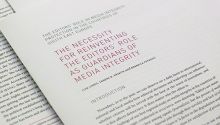A media empire cracking – from biased partisanship to independence


An oligarch struggles to keep the (media) empire together, after a long-time friendship with PM Orbán.
Back in 2002, when the Fidesz party has lost the parliamentary elections, the right-wing intelligentsia believed that the loss was partly due to not having a right-wing media empire. Thus, several media outlets established during the upcoming years, amongst others HírTV, Radio Lánchíd, newspapers Magyar Hírlap and Magyar Nemzet, were ideologically transformed in order to serve the needs of the right-wing public, which has been partisan readership, just as the journalist society itself – having long traditions in Hungary. Former Prime Minister Viktor Orbán himself promoted these media outlets announcing for instance that Magyar Nemzet was his favourite newspaper.
Most of these newly established or transformed media outlets covertly belong to Lajos Simicska1, the ex-cashier of Fidesz. Simicska has other businesses too: his companies, primarily the Construction and Metal Structure Manufacturing Company Közgép, received many of the public procurements and lead major constructions in the country2.
Simicska and Orbán have known each other since the 1980's, they have even shared their dormitory rooms. In the 2002–2010 period, when Fidesz was in opposition, the right-wing media empire connected to Simicska was serving the communication needs of Fidesz in scrutinizing the left-wing government. It is telling that in many cases concerning Magyar Nemzet the court obliged its publisher for rectification. When in 2010 the Fidesz, in coalition with the Christian Democrats (KDNP), won the elections, state advertising funds were transferred from left-wing to right-wing media outlets.
But after the Fidesz–KDNP coalition won 2014 elections, shadows appeared on the mutually beneficial cooperation of Simicska and Fidesz. The party decided to cut back the economic power of its oligarch, causing revenue loss for the companies of Simicska3 and gossips emerged that the relationship of the two old friends is controversial, to say the least.
The last drop was that the government wanted to expand the advertisement tax to smaller media outlets as well, and given that this would have burdened Simicska who had been exempted from the taxes before, he announced “a total media war”, but the leaders of the media outlets connected to him resigned in protest4. The tax, introduced in 2014, hard previously especially affected the leading private national broadcaster RTL Klub, which since then started heavily scrutinizing the government.
Prior to this day Simicska was like a ghost: he never gave interviews, he could be barely seen on press photos. But on February 6, 2015, he was giving phone interviews to almost all left-wing media outlets, calling Orbán a “scum.” He even stated that he is not going to be a partner to Orbán in building a dictatorship5. Since then, media outlets associated with Simicska became somewhat critical to the government.
In early October 2015, an interview was published on Kreativ.hu with Péter Tarr, the deputy director of HírTV. He said that prior to February 6, 2015, people responsible for the communication of the government weekly went to the headquarters of HírTV for briefing. On these briefings it was discussed who would be invited to the programmes and what topics will be dealt with. During that period, the extreme-right wing party Jobbik was boycotted, and there were barely any actors from left-wing Democratic Coalition and Hungarian Socialist Party appearing in their program as well. However, after February, a governmental boycott was launched against HírTV, and the journalists were encouraged to “forget self-censorship, the old reflexes, and...try to act as free, independent journalists”, Tarr said6. Of course, government denied any kind of interference into the editorial policy of HírTV.
Analysts agree that the dispute between the two former friends could last for a while, at least until Simicska has money to keep its media outlets alive. As state advertising funds were withdrawn, it is questionable whether his media empire will survive until the next elections. During this struggle, another right-wing media empire is being built by other oligarchs. The stance of the governing party became clear when on the Facebook fanpage of Viktor Orbán a photo was posted depicting him reading Magyar Idők, a daily belonging to the new media empire.
1 Attila Bátorfy, How did the Viktor Orbán – Lajos Simicska media empire function?, Published by SEE Media Observatory, April 10, 2015; Available at:
http://mediaobservatory.net/investigative-journalism/how-did-viktor-orb%...
2 Lajos Simicska, The Orange Files; Available at: http://theorangefiles.hu/lajos-simicskakozgep
3 Ibid.
4 Total media war? Senior pro-government media figures resign after former strongman turns against cabinet, February 6, 2015; Available at:
http://hungarytoday.hu/news/total-media-war-43752
5 Benjamin Novak, Lajos Simicska: I will not be Orban's partner in building a new dictatorship, February 8, 2015; Available at:
http://budapestbeacon.com/featured-articles/lajos-simicska-i-will-not-be....


